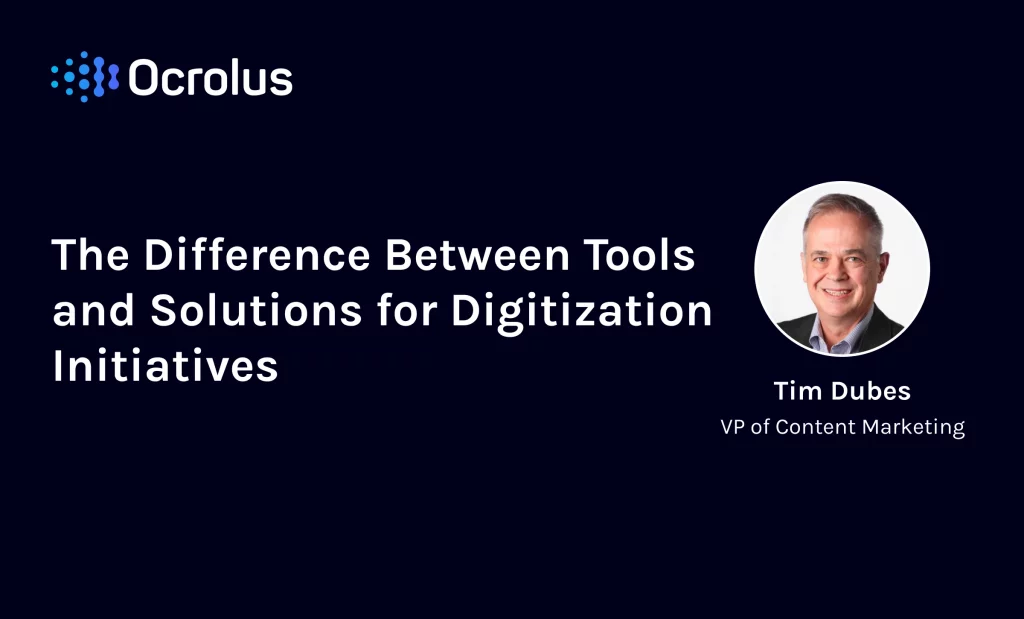This website uses cookies so that we can provide you with the best user experience possible. Cookie information is stored in your browser and performs functions such as recognising you when you return to our website and helping our team to understand which sections of the website you find most interesting and useful.
Document Digitization: The Difference Between Tools and Solutions

When you’re planning document digitization initiatives or making a substantial technology platform investment for your company, are you thinking:
- “I’d like to deploy a system where I can take the most mundane aspects of my processes and get better at them?”
- Or “I’d like to eliminate the most mundane aspects of my process?”
At first glance, it may seem like a semantical spin on the same concept, but in practice, the two statements lead to very different approaches and outcomes for document digitization initiatives.
Consider the process of onboarding documents for loan origination and underwriting. For years, lenders have turned to legacy document and data capture vendors who addressed this business challenge with increasingly complex and sophisticated programs. From document digitization (“Scanning, no need for filing cabinets!) to OCR (“No more manual data entry!”) to RPA (“robots will automate document classification and data extraction!”)
What each of these evolutionary steps in technology has in common (and any technology cycle that takes over two decades to develop is at best evolutionary) is that they address the first iteration of the fintech investment quandary. Meaning, they are document digitization applications that make it faster and easier to convert documents into actionable data. In exchange for your purchase and investment in time to learn and implement the software, you will automate a major portion (usually over 50%, if website claims are to be believed) of the human “work” involved in a process.
For example, read the case studies posted on data capture vendors’ websites. They usually explain how the software shortened loan approval times, allowing customers to close more loans with less work. Or how their customer used to employ 20 data entry operators, and now they only need 10 to complete the same number of loans. It’s great to be more productive, but essentially you are still in the data entry business.
The Difference between a Tool and a Solution for Document Digitization
This is why legacy capture software often acts as a tool and not a solution. In this case, here are the main differences between tools and solutions:
- A solution allows you to focus on the intellectual, critical core aspects of your business and remove supporting tasks from consideration;
- A solution doesn’t require or your staff to be trained on its usage; and,
- A solution doesn’t take months to implement.
Of course, there is value in investing in document digitization tools. But to get to the point where you are “eliminating mundane aspects” of a process rather than “getting better at mundane tasks” you need to evaluate document digitization technology investments as solutions.
As long as processes are initiated by documents, there will be a requirement to review documents and extract data. But when it comes to a tool versus solution approach–when onboarding borrowers for example, you should look to remove data entry from the process.
Instead of a tool approach to document digitization, which allows you to:
- Scan documents
- Perform OCR
- Review and make corrections
- Upload data to your LOS
The solution approach to document digitization is:
- Capture documents in your LOS
- Data is populated in your LOS
Humans and the Document Digitization Process
Of course, a solution is not as simple as scan and convert, but as a platform, or more appropriately as a service call from the LOS, to the user it should appear to be a one-button solution. This is the philosophy that Ocrolus has taken in building asset and income verification solutions. It centers on several fundamentals:
- Develop a deep understanding of the critical document types required for loan underwriting.
- Use the latest machine learning and AI technology to classify documents and extract relevant data through document digitization solutions.
- Incorporate data validation experts within the process to direct robotic processing for data capture and extraction.
- Offer this service as an API call within existing core mortgage systems.
In practice, humans are not removed from Ocrolus’ data capture process, they are integrated into it, using attended machine learning. The difference is that humans are part of the process, and specialize in data analytics, rather than using data entry operators, or even worse, loan underwriters as data entry clerks. The human-in-the-loop model fulfills the promise of capture solutions: eliminating manual data entry and encouraging document digitization
Contact us today to learn more about the benefits of the data capture process and document digitization.while allowing lenders to lend.






